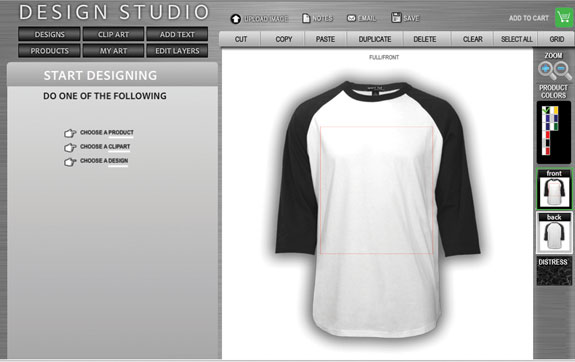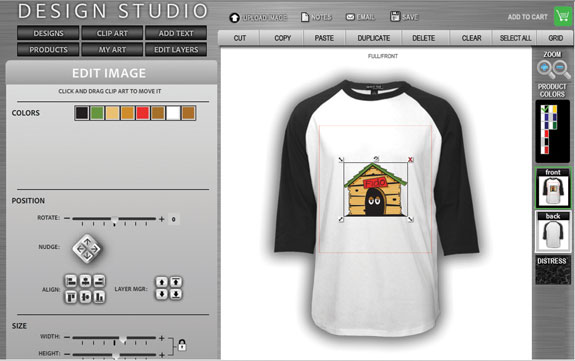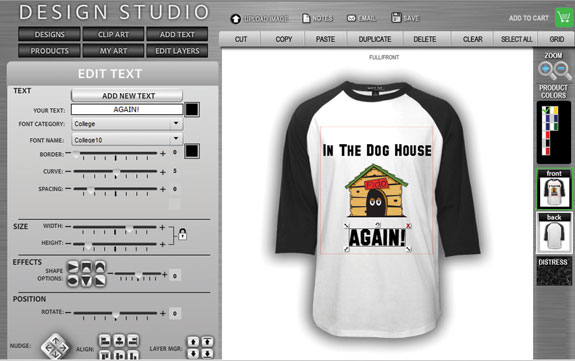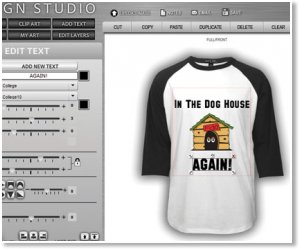Excellent article by Jimmy Lamb. A very concise overview of the business opportunity of online product configurators like InkSoft.
By Jimmy Lamb
Product configurators are all the rage in the world of online retail, showing up in marketplaces far beyond apparel decoration. To put it simply, these programs are a web-based e-commerce solution that allows customers to design, edit, approve and pay for a custom product totally on their own.
For example, boat manufacturers such as Mastercraft and auto producer Jeep (www.mastercraft.com/home/dab and www.jeep.com, respectively) both offer online programs that allow visitors to build their own boat or car to be submitted to a dealer for pricing and ordering info. Retail giant Pottery Barn has an interesting configurator that lets people design a bed (www.potterybarn.com/shop/bedding/design-your-own-bed/?cm_type=gnav). In fact, most that have spent any time online have likely used a product configurator of some sort without even knowing what it was.
But configurator programs also offer a huge opportunity for professionals in our industry as well. For example, a DTG print shop might setup a product configurator that would allow the customer to choose from a catalog of shirts, select a design from an online gallery to which custom text could be added to create the ideal garment. Using a collection of online tools, users can size and place the image and text wherever they wish and make changes as they go. The configurator shows them exactly what the final product will look like. In addition, the price of the garment is continually adjusted based on the selections. Once satisfied with their creation, customers can enter credit card info and complete the order. The decorator then receives the order details and the print file, ready to run.
 |
|
Typically, the first stop for a customer is an online product catalog where they choose from the items you have to offer. Ideally, they will be categorized by style, color, size, etc. Once the product is selected, it’s transferred into a design area where it’s prominently displayed along with a tool palette. Most systems will offer multiple product views (front, back, left sleeve, right sleeve) and enable adding separate decorations to each. (All screen shots courtesy the author, taken from inksoft.com)
|
 |
|
The key designer tools are images and lettering. Images or clipart are usually stored in a gallery with a breakdown of categories for easy viewing.
|
Within our industry, the two largest and most well-known companies that have actively embraced product configurator technologyare Café Press (www.cafepress.com) and Zazzle (www.zazzle.com). Both have built their business around the concept of providing customers the opportunity to create personalized products online, 24/7. But this isn’t just about creating unique items; it’s also an example of on-demand short-run production.
On-demand production refers to the ability to create products when ordered. Traditional retailing involves building up an inventory, selling it off and then replenishing. In most cases, the higher the quantity, the lower the production cost. But with on-demand production, the offering party keeps little or no inventory on hand (other than blanks) and produces the final product when it has been bought and paid for.
Because many configurator-generated orders tend to be smaller in size (as little as one piece), on-demand production is typically a necessary option. Of course, the product configurator settings can define minimum order requirements, but the very nature of the system is such that it tends to draw in potential customers looking for smaller orders. On the positive side, custom orders tend to generate much higher margins. Thus, decoration solutions that have little or no real setup time are excellent candidates for use in conjunction with product configurators. On the other hand, there is nothing that prevents fulfilling imagers from taking on large orders with the system.
Customer-generated in all its glory
Some of the systems being used by the big name players of retail are custom-built, costing tens of thousands of dollars and many years to fully develop. However, there are several really good, off-the-shelf configurator products that are extremely affordable and geared specifically to our industry. It’s important to note that each product has its own set of functions and tools.
For example, some systems permit users to upload their own artwork to use in place of stock designs, adding a higher level of personalization but also potentially compromising the quality of artwork””even with detailed instructions specifying the acceptable size and quality of images. Also consider that one of the key benefits of a product configurator is that it automates the order-taking process. This purpose is defeated if each customer that uploads poor quality images has to be contacted.
Most systems have a designated design area, which limits the size, amount and location of the text to prevent customers from creating designs that can’t be produced. The option of setting up specific design areas for each product will likely be available in the configurator’s admin function.
The power of a configurator is that it offers customer interaction with the order process. They can literally see the changes and won’t be blindly placing an order. Because the customer is choosing and visually verifying all the parameters of the job, including spelling, the opportunity for delivering an incorrect order is significantly diminished.
 |
|
In general, a design center will allow images to be resized, rotated and mirrored as a minimum. In some cases, the customer can also recolor the image, depending on the type of file being used and, of course, the capabilities of the system.
|
 |
|
With any basic text program, lettering functions allow the customer to choose fonts, resize lettering, arc text and place it where they need it. Customers can play with their creation as much as the system allows, changing out fonts, varying lettering colors, manipulating text characteristics, substituting different images, etc. Once pleased with the finished product’s appearance, the client can pay for and initiate the job, all online. A copy of the order is then sent to you and the customer.
|
Simplify the system
As powerful as a good product configurator program is, there are still some basic challenges. The first: there may not be a perfect product out there that does every single thing on the list. When considering a program, analyze what makes sense from the perspective of keeping it simple for the customer. Consider whether a specific feature will enhance a customer’s ordering experience. Too many choices typically lead to frustration and confusion, which may inhibit the entire sales process. Along those same lines, the more advanced the feature list becomes, the more expensive the configurator will be. Play with the demos online and stick with something easy and effective.
It’s also important to think in terms of the decorating technology; printing versus embroidery. Designs (text and clipart) to be printed afford the customer plenty of latitude in sizing, placement and font choice. However, resizing beyond 10″“20 percent can be detrimental in terms of design quality especially with fonts with embroidery. Additionally, the field of embroidery fonts is much narrower than that of print fonts because of sewing limitations. Thus, those who offer both must determine how to differentiate the two forms of decoration. Some systems actually interface with embroidery design functions when the embroidery is selected by the customer; the parameters and options change accordingly.
Pricing can also be a challenge. Far too many decorators get hung up on a complicated system that charges by the letter, word or, worse yet, stitch count. These are alien concepts to customers and, to be honest, quite annoying as well. Focus on sound retail practices and try to adopt a flat-rate system as best you can. For example, offer a polo shirt with left chest embroidery for “X” dollars. Limiting the design area will limit customers from producing an image so large to where it hurts the bottom line.
Join the revolution
Product configurators are revolutionizing how online business is conducted. More and more, consumers want to be free to research and experiment on their own without having to interface with sales reps and product specialists. E-commerce has already reshaped our industry. As apparel embellishers react to the demands of the customer, systems such as product configurators are going to be a necessity to keep business moving forward.
via Printwear: Product Configurator Software








hello, I’m french I do not speak English well. I specialize in the manufacture of supports menu for restaurant and I want my customers to them even their personalized menu folder. my question is can I integrate myself any forms
in the studio: rectangle, square with my own measurements? I do not sell t-shirt or hat
thank you